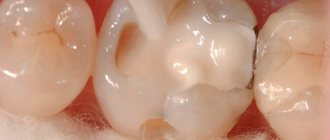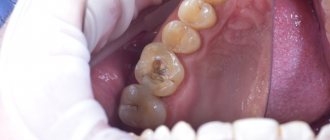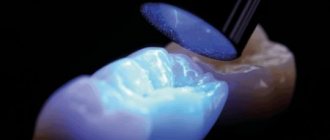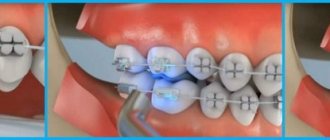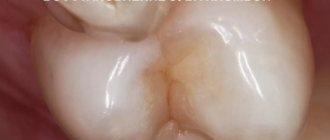Modern people do not visit the dentist as often as recommended. Usually a visit is associated with severe pain, when it is no longer possible to endure. Because of this, most patients are unaware of innovations in the world of medicine.
For many of us, a filling made of composite materials is the only option to plug a hole in a tooth. Few people know about the existence of ceramic and plastic fillings, not to mention advanced light fillings. Let's find out what a light filling is, the features of the most advanced fillings at the moment, and what their price consists of.
Features of installing light seals
An ordinary composite chemical filling, which is placed in any clinic, is distinguished by its affordable price and fragility. It hardens quickly as a result of mixing chemical components. There is no need to talk about the aesthetics of such a filling. It does not have a variety of colors and cannot be sanded in detail after installation.
The light filling hardens under the influence of ultraviolet radiation, until this moment the filling remains plastic . The dentist has no time limit to perfectly form a filling for a damaged tooth. Recreating the correct tooth shape is only possible with a light filling.
A photopolymer filling consists of a main filler and a substance susceptible to UV light. When exposed to ultraviolet radiation, two processes occur simultaneously: hardening of the filling and color polymerization.
The filling of the filling is chosen depending on the task at hand. For molars, whose main task is to chew food, fillers with large and coarse particles are intended. They don't look as nice, but they last longer.
For incisors (front teeth), aesthetics is much more important. These teeth come into contact with food only during a bite, so fillers with fine dust-like contents are intended for them.
What does the filling look like?
A filling is a material that, when hardened, forms a plug that prevents microbes and food from entering the tooth tissue. The composition includes substances with high viscosity and rapid hardening. In modern dentistry, they can be made from light-curing or chemical composites, glass ionomer or zinc phosphate cements.
All filling materials, regardless of type, purpose and service life, must meet the following requirements:
- safety for the body;
- hypoallergenic;
- strength;
- ease of installation and removal;
- drug resistance.
Today, dentists offer patients a large selection of fillings, so doctors often ask questions regarding the choice of filling material. To make it easier to answer, let’s look at the main types of dental fillings in more detail.
How much does a light filling cost and why?
The cost of a light seal puts off many patients until they learn the real benefits of this approach. Prices for such fillings in different clinics range from 500 to 1000 rubles. But this is not the limit, because additional work is paid separately. As a result, the amount can grow to several thousand rubles for one filling.
What the patient pays for:
- Anesthesia if necessary (cheap or expensive, public clinics also offer free anesthesia)
- Removal of damaged tissue
- Cleaning the tooth before filling
- Polymer matrix
- Main filler (Silicon dioxide or glass ceramics)
- Binder
The clinic uses imported components for light fillings. The main suppliers are: USA, Japan and Germany. Analogues are being developed in Russia, but so far they are not on the market. The cost of the filling also depends on the country of origin. The quality of the composites is at a high level.
We advise you to find out in advance how much you will have to pay for each cycle of work. It’s better to choose a “turnkey” filling with anesthesia and x-rays for a certain price than to then quarrel with the administration and find out the reasons for the high bill.
Composite filling - what does it mean?
The composite material has a heterogeneous structure and consists of two or more components with different properties. Their combination allows you to use the optimal capabilities of each component.
The consistency of a composite filling can be plasticine or liquid, which makes it easier to fill carious cavities. The material is then cured under the light of a curing lamp, and the excess is sanded down and removed by the dentist. As a result, the restored tooth looks healthy.
Stages of installing a seal
Installing a light seal is a lengthy process, but the result is worth it. The patient receives not just a patch for the tooth, he receives an almost new tooth with artificial filling. This step does not include pain relief because it is only used when necessary.
- First, the dentist examines the damaged tooth, removes damaged tissue, and disinfects the internal and external surfaces of the tooth. If necessary, grinds a hole to the required diameter
- Once all the preparatory work has been completed, the doctor dries the surface of the tooth so that saliva does not remain under the layers of the filling.
- A light-sensitive polymer is placed into the resulting cavity layer by layer. Each layer is dried until hardened, after which a new one is applied
- The very last top layer requires special attention. The dentist’s task is to recreate the surface in such a way that the tooth is reconstructed to its original state
- Before exposing the final layer to ultraviolet light, the dentist checks the interaction of the tooth with the opposing teeth. The bite should not change
- After the filling has hardened under exposure to light, it is ground and polished to resemble a natural tooth.
- The final stage will be an x-ray of the tooth to make sure there is no air and moisture in the dental cavity. Typically, this service is paid additionally
Indications for installation
Dentists use light composite if:
- it is necessary to remove carious cavities of any size, including very large ones;
- unsightly stains have formed on the enamel that need to be “camouflaged”;
- as a result of the injury, a large chip appeared (at least 50% of the crown must be preserved);
- there are minor defects in the top layer - scratches, chips, cracks;
- you need to fill the “hole” in the neck of the tooth;
- it is necessary to fix the holding structure while bridging adjacent units.
This type of filling allows you to solve a variety of dental problems, ranging from aesthetic to functional. It is noteworthy that there are no absolute contraindications to the installation of light-curing material. The only limitation is an allergy to any coating compound. But most often you can choose an alternative.
Light fillings on front teeth
When it comes to the aesthetics of the oral cavity, all dentists recommend installing a light filling. No other is able to fit into the dentition in such a way that there are no differences.
The light-curing filling has a large number of colors and shades. Once you have decided to have it placed, your dentist will select the shade of the filling based on the color of your tooth. This is a critical moment for the front teeth. The boundaries of the light seal are almost impossible to see.
When are composite fillings installed?
A light-curing filling is used in most cases to fill cavities in teeth. Indications for installing a composite filling may be:
- caries
- toothache
- discoloration of teeth
- mechanical damage to teeth
Composite fillings are less invasive and can restore missing tooth structure. They can be used correctly on all teeth. They are also used to fill cavities in children's baby teeth or to replace existing black amalgam fillings.
Advantages and disadvantages
There is nothing better than a natural healthy tooth. Therefore, any dental intervention will have its pros and cons. A light filling certainly has more advantages.
Advantages
- High plasticity of the filling for an unlimited time, which makes it ideal. The material will not harden at the most inopportune moment
- Safety for the patient, no side effects. The filling can be placed on children and pregnant women. No toxins
- A large color palette from which the doctor can select a color that is indistinguishable from the natural tooth of each individual person
- Durability
- A correctly formed filling does not cause any discomfort to the wearer.
- A light-curing filling can restore a tooth, even if more than half of the bone tissue is destroyed
- Almost instant bonding with the tooth. After an hour you can already consume food in most cases
Flaws
- The first and main disadvantage is the high cost. Of course, it is not formed out of thin air; you will definitely be pleased with the result. But a fact is a fact
- The light seal cannot be placed in hard-to-reach places. Such fillings do not cover external cervical caries of “sevens” and “eights,” for example. Because the ultraviolet lamp will not be able to illuminate the surface of the tooth, and the filling will not harden properly
- For several days, you should not consume food or drinks that are coloring, so that the filling does not change its color.
- Over time, the color may change and move away from ideal similarity due to incomplete polymerization
How long after a light filling can I eat?
Dentists recommend not eating for exactly one hour after you leave the office with a new tooth. Much depends on what size filling is installed and what percentage of the tooth was initially damaged.
- If a filling is placed in a tooth with a small hole, that is, it can be done immediately after installation, there are no restrictions. True, such situations rarely happen.
- If the tooth damage was moderate, then it will be enough to refuse food for an hour
- If the tooth has been restored, if there is now more filling material on it than bone tissue, then refrain from eating for 2-3 hours. After three hours of waiting, you can definitely eat no matter how much dental work you do.
How long does the filling last after installation?
Light seals have a lifespan of 5 years. Much depends on oral care and nutrition. With proper care, a filling can last more than 10 years. There are certain recommendations for extending service life:
- Maintain daily oral hygiene. Good brushing of teeth in the morning and evening, mouthwash and floss throughout the day. Your dentist can recommend a toothpaste to you based on the condition of your mouth and the sensitivity of your teeth and gums.
- Stop smoking. It greatly reduces the service life. A polymer filling has high strength, but a natural tooth does not. By destroying the natural foundation for the filling, you destroy the filling itself.
- Try to avoid sudden changes in temperature in the oral cavity. Do not drink hot soup with ice water, as this will cause microcracks in your teeth. Because of this, the structure of the restored tooth is disrupted, the filling may lose contact with the tissue and fall out
- Eat more solid foods, especially fruits. Contrary to misconceptions, hard food does not cause any harm to enamel and fillings, unless you chew bones, of course. One apple can provide additional teeth cleaning throughout the day
More details about the new product
Experts say that filling is not a treatment, but a camouflage of the tooth. In essence, this is how it is. This technique was first used in German dental centers. The liquid composition acts as a kind of high-strength sealant; it fills every microcrack in the unit, thus making it impossible for pathogenic microorganisms to penetrate. If you perform this procedure at an early stage of the disease, you can completely and irreversibly get rid of caries. If we were talking about an advanced case, most likely, sooner or later the carious cavities will make themselves felt again.
This development acts as an alternative to drills and other methods of caries treatment that require anesthesia. This filling is unique because its installation does not even require local anesthesia. The effectiveness has been proven in numerous tests, but in the case of large carious cavities this technology is not used.
conclusions
A photopolymer filling is the most perfect way to restore a damaged tooth to almost its original condition. Durability, lack of side effects and restrictions have made this technology popular all over the world. Reviews about such fillings are the most positive.
Such fillings cost several times more than chemical ones, if only because all the components are imported from abroad. But if you consider how long light seals last, then you can and should come to terms with the prices.
Choose a high-quality clinic, find out exactly how much and what you are paying for, and do not forget to take care of your teeth so that the filling serves you much longer than its intended period.
